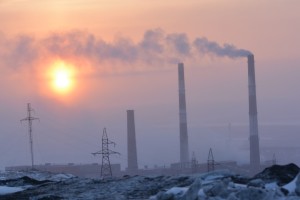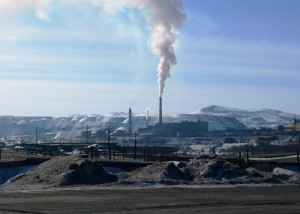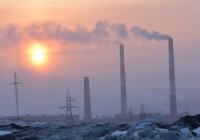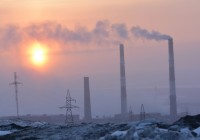
Incomplete combustion of dirty-oil caused black smoke in border area
ADVERTISEMENT
Norwegian Institute for Air Research (NILU) this weekend measured levels of sulphur dioxide (SO2) exceeding the maximum allowed limits by 3 to 4 times.
The automatic measuring station at Karpdalen outside Kirkenes registered values over the permitted level of 130 mikrogram per cubic metre on Friday, Saturday and Sunday.
“We had nine hourly averages over 350 microgram per cubic metres on Friday morning, of which six values were over 500,” says Senior Scentist Tore Flatlandsmo Berglen with NILU.
He concludes the sulphur dioxide source is either in Nikel or Zapolyarny, the two industrial towns on the Russian side of the border.
Tore Flatlandsmo Berglen says to The Barents Observer that Nikel’s district heating plant hasn’t earlier been considered a source to SO2 emission. “This is interesting and it would be useful to find information about such emissions.”
Mazut «Dirty oil»

Like most district heating plants in Russia, the one in Nikel burns mazut, a heavy, low quality fuel oil. The mazut is almost exclusively manufactured in Russia and some few other former Soviet republics. Mazut is rather similar to Number 6 Oil in western refineries, often referred to as “dirty oil” – the products left over after gasoline and lighter petroleum components are evaporated from the crude oil.
ADVERTISEMENT
Mazut is mainly used in large boilers for making steam for heating, and can contain 2 to 3,5 percent sulphur content. That is the main reasons why most northern cities in Russia smell sulphur during winter when the heating plants run on full capacities.
Norilsk-Nickel main source to cross-border air pollution

The heating plant in Nikel does normally not emit such black smoke as captured on this instagram photo. Such black smoke could be a result of very bad quality of the mazut, incomplete combustion, or a combination of the two.
The main sources of SO2-emission in the Norwegian-Russian border areas are, however, the nickel pellets plant in Zapolyarny and the smelter in Nikel. Kola GMK, a subsidiary of the giant Norilsk-Nickel mining and metallurgical combine, operates the two plants.
Nikel on Russia’s worst air quality list
Rosstat, Russia’s Federal State Statistics Service, last Friday listed the town of Nikel among the most polluted cities in Russia in regard to air quality. Other cities on the list include Nizhny Tagil, Chelyabinsk, Perm, Ufa and Ulyanovsk, reports news service Rosbalt.
The top three most polluted cities are Chita, Ulan-Ude and Magnitogorsk. The article does not tell why the city of Norilsk on the Taimyr Peninsula is no longer the worst-on-dirt list.




